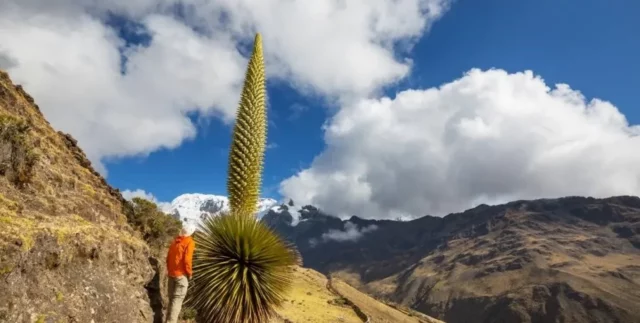«`html
Discovering the «Queen of the Andes»: The Largest Bromeliad on Earth
Imagine standing high in the Andes mountains, surrounded by some of the most breathtaking scenery on the planet. Here, amidst the rugged peaks, thrives a truly extraordinary botanical marvel known as the «Queen of the Andes.» This towering plant, which can grow up to an astonishing 12 meters tall, isn’t just the largest bromeliad in existence; it also boasts a captivating life story that will leave you in awe.
A Glimpse into History
The journey of the «Queen of the Andes» began over two centuries ago when the esteemed French naturalist Alcid d’Orbigny first laid eyes on it. However, it wasn’t until 1874 that renowned scientist Antonio Raimondi officially classified it as Puya raimondii. Imagine the excitement of discovering a new species that belongs to the same family as pineapples, yet stands in stark contrast with its stunning size and spiky appearance.
Where Does the Queen Reside?
What’s truly remarkable is where this giant plant calls home. The «Queen of the Andes» thrives at elevations between 3,000 and 4,800 meters, predominantly on northern-facing slopes throughout a regional reserve in Peru. Picture yourself wandering through this reserve, where over 45,000 of these magnificent specimens flourish, standing proudly amongst the harsh Andean landscape. It’s a vivid testament to nature’s mastery of adaptation and survival.
For those who relish engaging with nature, visiting this reserve allows you to witness a breathtaking spectacle. Imagine the thrill of spotting one of the rare flowering events, which occur only once every hundred years. A true rarity, this flowering phenomenon draws not just botanists, but adventure seekers and nature enthusiasts from around the globe.
Why the «Queen of the Andes» Matters
The significance of the «Queen of the Andes» extends far beyond its majestic stature. This incredible plant plays a vital role in promoting biodiversity, particularly in high-altitude ecosystems that face increasing threats from climate change and human activity. In fact, studies show that high-altitude ecosystems are among the most vulnerable on the planet, with a substantial percentage of plant species facing extinction.
- Conservation Efforts: As of now, organizations around the world are working tirelessly to protect the fragile habitats of these majestic plants.
- Biodiversity Importance: The «Queen of the Andes» serves as a crucial indicator of ecological health in these regions.
- Inspiration for Future Research: Ongoing studies are being conducted to uncover more about this unique plant and its ecological contributions.
In the quest to protect our natural world, the «Queen of the Andes» stands as both an inspiration and a reminder of the urgency needed in conservation efforts. As we continue to explore and understand the intricacies of high-altitude ecosystems, we not only celebrate this extraordinary plant but also reaffirm our commitment to preserving the awe-inspiring wonders of nature.
So, whether you find yourself planning an adventure to Peru or simply enjoying nature from afar, remember that the «Queen of the Andes» symbolizes resilience and beauty in the face of adversity. Its story is a call to action for all of us to respect and protect the natural wonders that grace our planet.
«`





